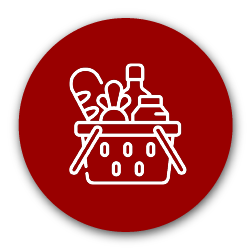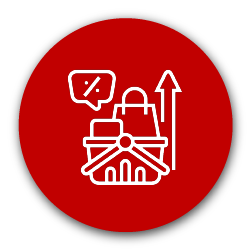
Stocking the right products and merchandising them appropriately on a shelf helps you achieve retail success. That's a given. However, these are not the only ingredients. There is also your retail floor plan. Your store layout plays a far more critical role in your success than you may give it credit. Without proper focus, it'll be difficult for your customers to find what they want.
That’s only the beginning. There are far more consequences that you’ll experience if you don’t pay close attention to the floor planning aspect of your retail business. That’s a different topic, which we covered in this article. Instead, we’ll focus on the positives - what you can expect to experience when you do implement data-driven retail floor plans in your business.
1. You can reduce floor congestion in-store
There is no doubt about the fact that you want more customers. After all, more shoppers mean you can make more sales, thereby increasing your profits. It's a no-brainer.
That said, having too many customers can work against you. Sounds contradictory, right? In the context of your floor plan and store layout, it's not controversial at all.
Let us explain.
Having more customers means you need to be careful about how you layout your store. If you're not careful, it can lead to floor congestion.
Floor congestion is when your store is too busy that it becomes unpleasant to shop.
If you fail to address this issue, it can lead to once-loyal customers choosing to shop elsewhere. Fortunately, it’s easy to address because there are primarily two reasons why it happens:
- Not implement data-driven planograms; and/or
- Incorrect floor planning
By incorrect floor planning, we mean setting up a store layout without looking at your data. And that’s why a data-driven retail floor plan is critical.
But how can a floor plan, built using data, help reduce floor congestion?
For one, it allows you to spread out high-trafficked categories across your store.
Because you're looking at your data, you can understand which products are your top-performers as well as where you've positioned them in-store. The last thing you'd want is to have all of your top-performing products in one or two areas of your store.
Need help combatting floor congestion? Learn how with our free ebook
It’s worth pointing out that you must have hotspots in-store. It’s not a negative thing. However, it is a problem if they are only in one or two areas. It’s better to spread them out across your store. Doing so means you can expose your customers to more of your merchandise.

2. You can increase the basket sizes of customers
At the beginning of this article, we mentioned the importance of a data-driven store layout. We've pulled that through with the first point and how you can use it to reduce any floor congestion.
Of course, there is more to it than that. There is also the point that a data-driven floor plan can lead to an increase in the basket sizes of your customers. In short, they spend more.
How?
Remember we spoke about spreading out your high-trafficked categories across your store? That allows for your customers to see more of your merchandise - we'll touch on it in more detail in another point below.
But it also links in with increases in the basket sizes of your customers. Because you are exposing your customers to more merchandise, your customers are buying more products.
Of course, you can't just place items anywhere expect them to buy them. You need to consider how to present them. You can do that by creating an ideal product or category flow. When you get this right, which you do by looking at your data, you encourage customers to buy more.
Complementary category placement within a store increases the chances of your customers buying more than what they had planned for when they first entered your store. At the same time, you're creating a better shopping experience because you're making it easier to shop in-store.
Let's consider the example of a woman coming in to buy a safety razor for herself as well as a few other toiletries. By placing shaving cream and razors specifically for men next to the safety razors, there is a possibility that she'll remember she needs to buy for her partner.
It's a small purchase. But imagine she visits other aisles with other products and does the same. If she has a newborn and she needs to stock up on baby formula, adding baby bibs next to the drop that holds all the baby foods means you've exposed her to more items. You're also planting an idea in her mind that she might need a new bib because she doesn't have enough.

3. You can maximise the selling potential of your retail space
Shelf space is limited and as a retailer, it's one of your most valuable assets. However, it's not your only asset that you can use to your advantage.
There is also your retail space. How you decide to build out your floor plan can lead to a positive experience for your customers and more sales for you. It could also lead to a negative experience where you create a chaotic space that shoppers refuse to shop in.
Let's focus on the positives.
A data-driven retail floor plan can help maximise the selling potential of your retail space.
How?
It allows you to give each of your categories and the products in them the right amount of drops. Because you're looking at data, it means your products each receive the shelf space they each deserve. No product will get more space on the shelf than what it deserves
As a result, you're giving more space to your top-performers and reducing the space given to poor performing products. That's money in the bank - you're maximising the selling potential of your retail space.
Let's say your stock a Dental and Mouth Care category in-store and we'll look at the Toothbrush subcategory.
During your store analysis, you find that this subcategory deserves eight drops. However, you notice that prior to the analysis, it only received 6 drops.
Definition: A drop is a section of the gondola spanning one shelf length, from top to bottom.
Meanwhile, your Toothpaste subcategory deserves 3 drops but currently has 5 drops. In the case of these two subcategories, it's straightforward. You can increase the drop counts for toothbrushes and decrease the drops for your toothpaste.
Conclusion
A data-driven retail floor plan isn’t so much a nice-to-have as it is a must. You only need to consider the reasons above to supplement any argument you want to put forward.
Not only does it allow you to reduce any unnecessary floor congestion, but it can help you to maximise the selling potential of your store and encourage shoppers to buy more. There is also the point that because you create a store that is easier to shop, they’ll likely want to spend more time in it.
Are you looking to build out a data-driven floor plan but don't know where to begin? You can speak to DotActiv by booking a custom consultation with one of our experts.
If you have the knowledge and need specialist category management software to help, visit our online store here to browse our various software editions.
About the contributors
Brian Nyamachiri joined DotActiv in 2013. An operations manager with over 10 years of retail experience, he currently oversees Adcock Ingram, Danone, GSK, Dr Oetker, Loreal, Makro, Premier Foods, Revlon, and UPD accounts as operations manager. He has a Bachelor of Commerce in Supply Chain and Operations Management from Unisa.
Corli Pretorius joined DotActiv in 2020 as a retail space planner on the Dis-Chem account. She has since changed roles to floor planner, working on the same account. She has a Bachelor of Consumer Science with Business Management from North-West University.
Karike Pieters joined DotActiv in 2019 as a space planner for the Health and Pharmacy Department at Dis-Chem. Since then, she has changed roles to work as a floor planner. She has a BSc Degree in Consumer Science from North-West University.



